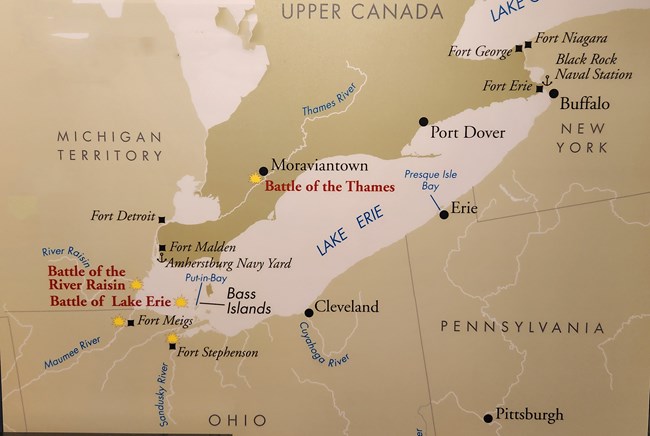
Importance of this BattleAt dawn, 10 September 1813, a United States Navy lookout spots six British vessels to the northwest of Put-in-Bay beyond Rattlesnake Island. Immediately, Master Commandant Oliver Hazard Perry issues a flurry of orders and makes preparations to engage the British in a naval battle.While naval travel is slow, taking upwards of a year to reach the Great Lakes from the British Isles, it is much faster, safer, and easier than traversing the woodlands of Upper Canada on foot. British posts on the western end of Lake Erie and around the Upper Lakes depend on shipments coming across the Atlantic. In order to get food, ammunition, and other military supplies the British navy have to sail past Put-In-Bay. With Perry's fleet on Lake Erie the British must fight or abandon their post at Fort Malden. American control of Lake Erie would sever the British supply route running from Port Dover, Ontario to Fort Malden (present-day Amherstburg, Ontario). 
NPS Photo Ships and ArmamentThe American flotilla comprised nine vessels: three brigs (Lawrence, Niagara, and Caledonia), five schooners (Scorpion, Ariel, Somers, Porcupine, and Tigress), and one sloop (Trippe). A sixth schooner, the Ohio, was also assigned to the fleet, but on the morning of the 10th, was on its way to Erie for supplies. The nine vessels carried 54 guns between them, Lawrence and Niagara being the most heavily armed, with 20 guns each.The British fleet had the advantage in number of guns, carrying 63 guns total. They were however, at a disadvantage when it came to number of vessels, only having two ships (Detroit and Queen Charlotte), one brig (General Hunter), two schooners (Lady Prevost and Chippewa), and one sloop (Little Belt). The British are armed primarily with long guns that can throw a cannonball accurately to about 900 yards. The American ships primarily armed with carronades have a range of about 450 yards. Though Carronades can inflict much more damage, but to do so, Perry needs the wind to at his back to advance within close range. Sailors, Marines, and InfantryBoth Barclay and Perry lacked experienced sailors and marines, and thus were forced to bolster their crews with landsmen. Perry managed to call up over 150 militiamen from various states as well as around 100 infantry volunteers from General William Henry Harrison’s Army of the Northwest.Barclay supplied his fleet with men from the Royal Newfoundland Regiment of Fencible Infantry and regulars from the 41st Regiment of Foot.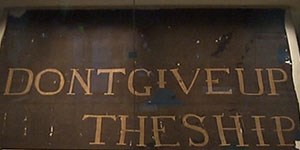
Photo copied from https://www.usna.edu/100Objects/Objects/index.php DONT GIVE UP THE SHIPErie, October 12th, 1813. “About 11 o’clock Capt. Perry produced the flag & having unfurled it, mounted a gun slide & said “My Brave Lads, this Flag contains the last words of the brave Capt. Lawrence. Shall I hoist it?” – “Aye, Aye” they said from all quarters.” [From Samuel Hambleton’s Diary, transcribed by Gerard T, Altoff]Captain James Lawrence was a friend of Perry’s. He was mortally wounded aboard the USS Chesapeake in June of 1813. While he was carried below deck, he called out to his crew, "DONT GIVE UP THE SHIP". Upon hearing of Lawrence’s death, Perry had a flag sewn with the words emblazoned across a dark background. The Wind Changes When the squadron sails from Put-in-Bay at 7 a.m., the American vessels are steering west-northwest. The wind is blowing from west-southwest. For more than two hours Perry repeatedly tacks his ships in an effort to put the wind to his back, but with no success. 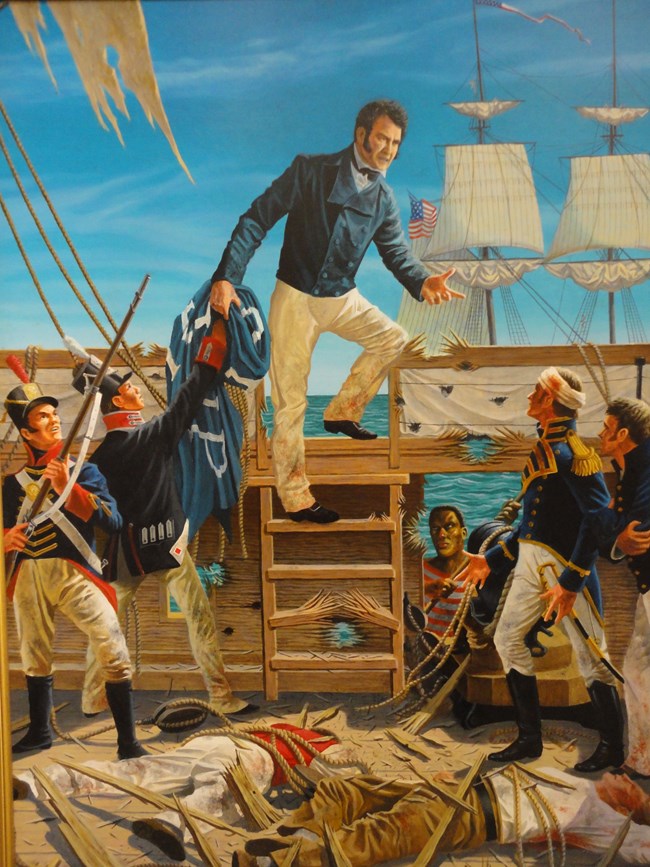
Artist: Dean Mosher The Battle of Lake Erie BeginsAt 11:45 a.m. the Detroit fires the first shot at extreme range. A 24-pound cannonball splashes harmlessly near the Lawrence. A few minutes later a second shot was fired, but this time the heavy cannonball punches through the bulwarks of the Lawrence. The flying splinters kill and wound American sailors. The Lawrence's carronades are still far out of range, so Perry issues orders to the Scorpion, with one long 24-pounder, and the Ariel, with four long 12-pounders, to open fire. For the next 30 minutes Perry struggles to close within range, during which time the Lawrence is taking damage from almost all the British ships.Challenges Mount Another problem for Perry is the small gunboats bringing up the rear of his battle line. Because the wind is light the little schooners and sloop fall behind early, even with all sail set and sweeps working when the battle opens they were still two miles away and out of range. At 12:15 p.m. the Lawrence closes within range of the British. The starboard guns unleash a broadside of 288 pounds of metal crashing into the British ships. Now, as soon as the Niagara moves in the advantage will rest with the Americans. Perry peers astern, expecting to see the Niagara edging in toward the Queen Charlotte, but instead of closing, Perry is shocked to see that Jesse Elliott shortens sail, nearly stopping the Niagara’s forward movement, a tactic which has the Niagara dead in the water. Elliott's actions are initially somewhat justified. The Caledonia, directly ahead of the Niagara, also shortens sail. The Caledonia's commander, facing the Queen Charlotte's vastly superior broadside, wisely decides to stand off and not jeopardize his vessel. Since one of Elliott's two procedural directives dictates that he maintain his position in line, Perry's second-in-command is simply following his superior's orders. Elliott opens with the Niagara's 12-pounder bow chaser, which in his current position astern of the Caledonia is the only gun within range. Changing PositionsAs the battle progresses the Caledonia continues to hesitate, so Elliott decides to range in front of the smaller brig. The Niagara's captain displays initiative by abandoning the rigid line-of-battle tactic, justifiably disregarding one of his superior's orders. Making this move Elliott can now follow Perry's second specific order, to engage his designated adversary at close range - the Niagara's pre-ordained opponent was the Queen Charlotte. But instead of moving starboard of the Caledonia and closing with the British line, Elliott eases the Niagara to the windward, angling slightly away from the enemy ships – yet still out of range. The reason for Elliott's questionable movement is still being debated, but regardless of motive the Niagara's carronades, almost 40% of Perry's total broadside strength, sits out of range.With the Niagara lingering to windward the Queen Charlotte's guns are rendered useless. The commander of the second largest British vessel, possibly not understanding his adversary's move but anxious to bring his guns to bear, allows his vessel to move forward of the General Hunter, where she can assist the Detroit against the Lawrence. Practically ignoring the smaller American support vessels, the Detroit, Queen Charlotte, and General Hunter focus their broadsides, pounding the Lawrence while the Niagara remains idle. Fighting desperately the American flagship inflicts considerable damage upon the British, but the Lawrence is eventually overwhelmed by superior firepower. DONT GIVE UP THE SHIP Raised AgainBy 2:30 p.m. the Lawrence is a floating wreck with every gun on her starboard side disabled and four of every five men either killed or wounded. Perry is facing the grim prospect of surrender. As he gazes across to the Niagara, still out of range and relatively undamaged, Perry makes a fateful decision. He collects four unwounded men, pulls down his battle flag, and transfers to the flagship's first cutter. They rowed through a hail of shot and smoke to the Niagara. Lieutenant John Yarnall, who has been wounded and returned to the deck three times, is left in command of the Lawrence.Miraculously, Perry and his boat crew reached the Niagara unscathed. Climbing aboard, Perry, dispatches Elliott in the cutter to hurry along the lagging gunboats. Perry then prepares the Niagara for immediate action, puts the helm up, and sails toward the British line. 
Library of Congress, Prints & Photographs Division, Detroit Publishing Company Collection A Blunder and The AdvantageThe British, though they have pounded the Lawrence into a crippled hulk, have suffered terribly. During the engagement Barclay is severely wounded, and the captain and first lieutenant of every British vessel is incapacitated. The English fleet is now commanded by junior officers - brave men, but with little or no experience maneuvering ships in combat. When they observe the Niagara bearing down on their line the British attempt to wear ship - to turn their vessels around to bring the unused starboard broadsides to bear. Orders are issued, but amidst the tumult of battle the battered Detroit and Queen Charlotte collide, becoming helplessly entangled.Taking full advantage of the enemy blunder, Perry steers the Niagara through the jumbled British battle line. Unleashing both broadsides, the Niagara ravages the vulnerable British ships. As it presses through the British line Perry backs the maintop sail, holding the Niagara stationary while her carronades decimate the enemy decks. The wind has also picked up, allowing the sluggish gunboats to rush forward and rake the enemy from astern. The British SurrenderA few minutes after 3 p.m. the British the four largest vessels surrender one by one. The gunboats Chippawa and Little Belt attempt escape but are pursued and snared by the Scorpion and Trippe. The entire British fleet has been captured.The vessels anchor and hasty repairs are underway near West Sister Island when Perry composes his now famous message to William Henry Harrison. Scrawled in pencil on the back of an old envelope, Perry writes, "Dear General: We have met the enemy and they are ours. Two ships, two brigs, one schooner and one sloop. Yours with great respect and esteem, O.H. Perry". What Victory MeansThe Battle of Lake Erie proves one of the most resounding triumphs of the War of 1812. The victory secures control of the lake, forcing the British to abandon Fort Malden and retreat up the Thames River. Harrison's army pursues, decisively defeating the British and its allied Indian force on 5 October 1813 at the Battle of the Thames. And later, during the peace talks, the dual victories of Lake Erie and the Thames ensure that the states of Ohio and Michigan remain the sovereign territory of the United States.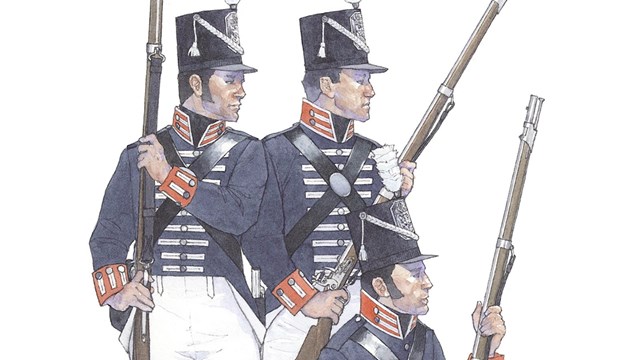
Battle of Lake Erie Roster
Sailors and soldiers served aboard the Battle of Lake Erie Fleet. Those who survived are noted on this page. 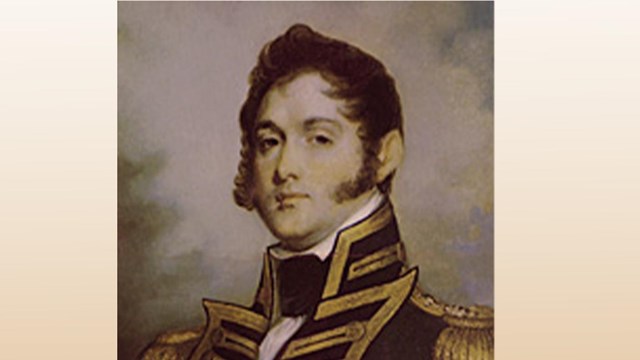
Oliver Hazard Perry
Who was Oliver Hazard Perry and what propelled him to Commodore rank? What was his success in the Battle of Lake Erie. 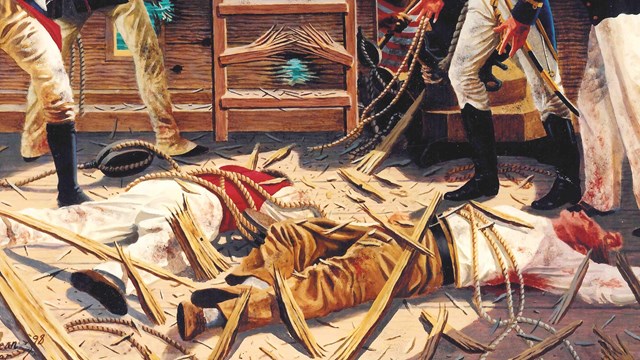
Killed and Wounded
Carved on the walls inside the Memorial's rotunda are the names of ships and the men aboard them who were wounded and killed in the battle. |
Last updated: July 26, 2025
